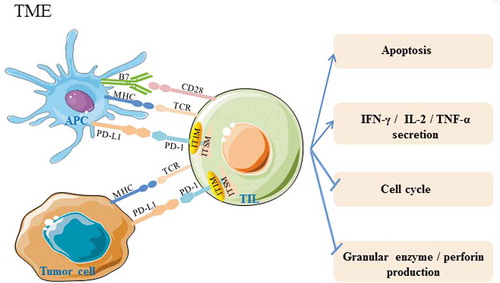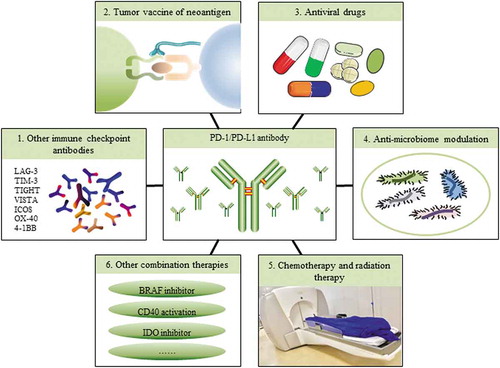Figures & data
Figure 1. PD-1 and PD-L1 interactions affect TIL function in the tumor microenvironment. In the tumor microenvironment, PD-L1 which can bind to PD-1, is abnormally highly expressed on tumor cells and APCs. Activation of PD-1/PD-L1 signaling can cause phosphorylation of tyrosine residues in the PD-1 cytoplasmic ITIM and ITSM structure domains, decreasing the antitumor activity of TILs by inducing apoptosis, inhibiting granular enzyme and perforin production, decreasing IFN-γ, IL-2, and TNF-α secretion, and stagnating the cell cycle. TCR: T cell receptor; MHC: major histocompatibility complex; APC: antigen presenting cell; ITIM: immune receptor tyrosine-based inhibitory motif; ITSM: immune receptor tyrosine-based switch motif; TIL: tumor-infiltrating lymphocytes. →:activation effect;“┤”inhibitory effect.

Table 1. Summary of current anti-PD-1 and anti-PD-L1 antibodies approved by the FDA.
Table 2. Combination therapies of anti-PD-1 antibodies in clinical trials.
Figure 2. Combination therapies with anti-PD-1/PD-L1 antibodies. Because of the complexity of the tumor microenvironment and the complexity of checkpoint regulation in TILs, only partially successful clinical results of PD-1/PD-L1 blockade have been achieved in certain tumors. Therefore, combination therapies are required. Ongoing studies, such as using PD-1/PD-L1 antibodies combined with other checkpoint antibodies, tumor vaccines, antiviral drugs, anti-microbiome modulation, chemotherapy and radiation therapies, or kinase or enzyme inhibitors are being developed. Combination therapies will be a future direction for cancer patient treatment.

